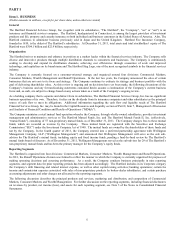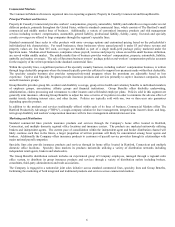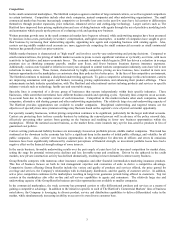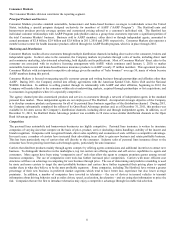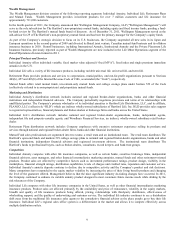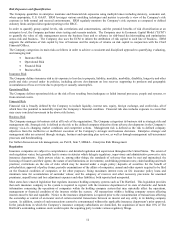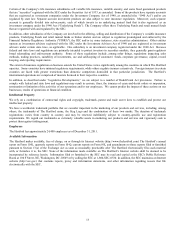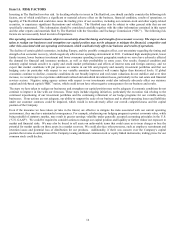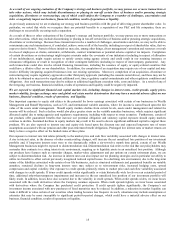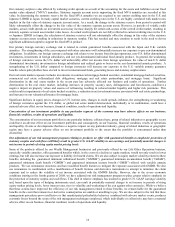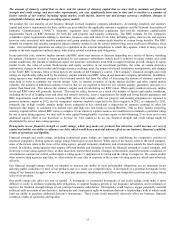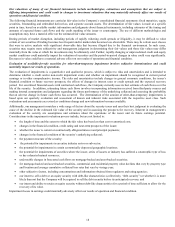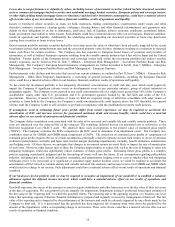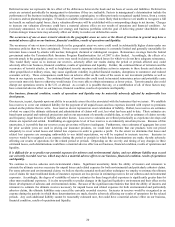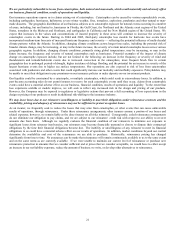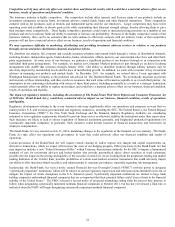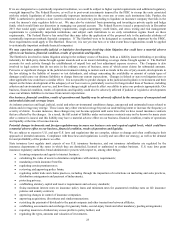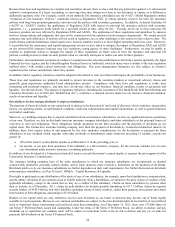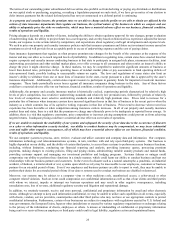The Hartford 2011 Annual Report Download - page 15
Download and view the complete annual report
Please find page 15 of the 2011 The Hartford annual report below. You can navigate through the pages in the report by either clicking on the pages listed below, or by using the keyword search tool below to find specific information within the annual report.15
As a result of our ongoing evaluation of the Company’s strategy and business portfolio, we may pursue one or more transactions or
take other actions, which may include discontinuance or placing in run-off certain lines of business and/or pursuing strategic
acquisitions, divestitures or restructurings, any of which could subject the Company to a number of challenges, uncertainties and
risks or negatively impact our business, financial condition, results of operations or liquidity.
As previously announced, we are evaluating our strategy and business portfolio with the goal of delivering greater shareholder value. In
particular, we noted that while we recognize there are potential benefits to a separation of our P&C and life companies, there are
challenges to successfully executing such a separation.
As a result of these or other evaluations of the Company’ s strategy and business portfolio, we may pursue one or more transactions or
take other actions, which may include discontinuing or placing in run-off certain lines of business and/or pursuing strategic acquisitions,
divestitures or restructurings. Because these transactions involve a number of challenges, uncertainties and risks, we may not be able to
consummate any such transaction or, if concluded, achieve some or all of the benefits, including in respect of shareholder value, that we
expect to derive from it. Pursuit of these initiatives may also, among other things, divert management’ s attention and resources or result
in a loss of employees or clients, surrenders, withdrawals, contract terminations or potential adverse capital or tax impacts. Completion
of certain divestitures or restructurings might require consents under the covenants of our indentures (including in respect of allocation
of our indebtedness), might require actions to satisfy certain rating agency criteria and could result in our retaining insurance or
reinsurance obligations or result in recognition of other contingent liabilities (including in respect of intercompany guarantees). Any
such transactions could also involve related financing transactions, including the issuance of equity or equity-related securities that
could have a dilutive effect on our shareholders. In addition, the completion of an acquisition may require use of our capital and may
involve difficulty integrating acquired businesses into our existing operations. Moreover, completion of an acquisition, divestiture or
restructuring may require regulatory approvals or other third-party approvals (including the consents noted above), and these may not be
able to be obtained or may involve significant additional cost, time, regulatory capital commitments and other regulatory conditions and
obligations. Any such transactions may also be subject to additional significant execution risks, costs and delays. As a result of any of
the foregoing, our business, financial condition, results of operations and liquidity could be negatively impacted.
We are exposed to significant financial and capital markets risk, including changes in interest rates, credit spreads, equity prices,
market volatility, foreign exchange rates and global real estate market deterioration that may have a material adverse effect on our
business, financial condition, results of operations, and liquidity.
One important exposure to equity risk relates to the potential for lower earnings associated with certain of our businesses in Wealth
Management and Runoff Operations, such as U.S. and international variable annuities, where fee income is earned based upon the fair
value of the assets under management. Should equity markets decline from current levels, assets under management and related fee
income will be reduced. Such a decline would also place greater stress on the variable annuities businesses, which requires significant
allocated capital due to rating agencies and regulatory requirements, including with respect to stress scenarios. Furthermore, certain of
our products offer guaranteed benefits that increase our potential obligation and statutory capital exposure should equity markets
continue to decline. Sustained declines in equity markets may result in the need to devote significant additional capital to support these
products. We are also exposed to interest rate and equity risk based upon the discount rate and expected long-term rate of return
assumptions associated with our pension and other post-retirement benefit obligations. Prolonged low interest rates or market returns are
likely to have a negative effect on the funded status of these plans.
Our exposure to interest rate risk relates primarily to the market price and cash flow variability associated with changes in interest rates.
A rise in interest rates, in the absence of other countervailing changes, will increase the net unrealized loss position of our investment
portfolio and, if long-term interest rates were to rise dramatically within a six-to-twelve month time period, certain of our Wealth
Management businesses might be exposed to disintermediation risk. Disintermediation risk refers to the risk that our policyholders may
surrender their contracts in a rising interest rate environment, requiring us to liquidate assets in an unrealized loss position. Although
our products have features such as surrender charges, market-value adjustments and put options on certain retirement plans, we are
subject to disintermediation risk. An increase in interest rates can also impact our tax planning strategies and in particular our ability to
utilize tax benefits to offset certain previously recognized realized capital losses. In a declining rate environment, due to the long-term
nature of the liabilities associated with certain of our life businesses, such as structured settlements and guaranteed benefits on variable
annuities, sustained declines in long-term interest rates may subject us to reinvestment risks, increased hedging costs, spread
compression and capital volatility. Our exposure to credit spreads primarily relates to market price and cash flow variability associated
with changes in credit spreads. If issuer credit spreads widen significantly or retain historically wide levels over an extended period of
time, additional other-than-temporary impairments and increases in the net unrealized loss position of our investment portfolio will
likely result. In addition, losses have also occurred due to the volatility in credit spreads. When credit spreads widen, we incur losses
associated with the credit derivatives where the Company assumes exposure. When credit spreads tighten, we incur losses associated
with derivatives where the Company has purchased credit protection. If credit spreads tighten significantly, the Company’ s net
investment income associated with new purchases of fixed maturities may be reduced. In addition, a reduction in market liquidity can
make it difficult to value certain of our securities when trading becomes less frequent. As such, valuations may include assumptions or
estimates that may be more susceptible to significant period-to-period changes, which could have a material adverse effect on our
business, financial condition, results of operations or liquidity.


